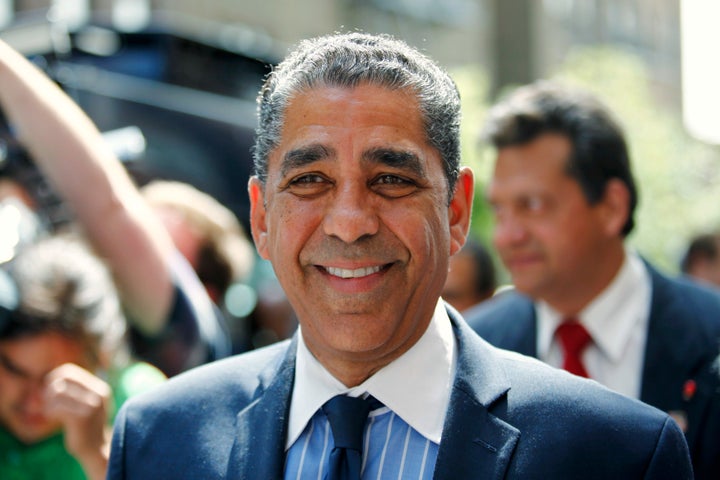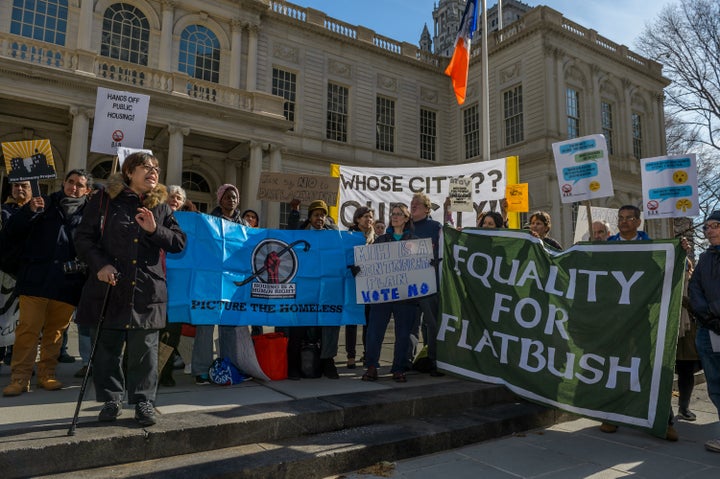
A New York politician has an offbeat plan to combat the pressures of rising rents and displacement in his neighborhood: federally designated anti-gentrification zones.
State Sen. Adriano Espaillat faces a crowded and contentious Democratic primary election Tuesday for the open seat in New York's 13th Congressional District. If he beats out his opponents and goes on to win retiring U.S. Rep. Charlie Rangel’s seat, he would represent neighborhoods in Manhattan and the Bronx.
Three of those, Central Harlem, East Harlem and Morningside Heights, are some of the most rapidly gentrifying neighborhoods in New York City, according to a May report from New York University’s Furman Center. Harlem, historically a center of black culture, has undergone significant changes. In Central Harlem, rents climbed 53 percent between 1990 and 2014. Since 2000, the black population fell from 77 percent to 55 percent, as the white population increased from 2 percent to 15 percent. The Hispanic population also increased, from 17 percent to 24 percent.
“Gentrification and income inequality and affordability are such an important issue for New Yorkers,” Espaillat said. “New York [is] becoming more and more expensive, and many families are having a hard time making ends meet, or are just moving elsewhere, because they just can’t afford to live here.”
Under Espaillat’s plan, Congress would designate "gentrification mitigation zones" in areas with large working class and minority populations, above-average increases in property values and signs of resident displacement. The districts would be subject to stronger protections for tenants whose housing may be at risk as developers and people with higher incomes move into a neighborhood.
In a gentrification mitigation zone, tenants of a building that’s put up for sale would have the first chance to buy it, with help from the U.S. Department of Housing and Urban Development to form a cooperative and receive federally backed loans. If renters opted not to buy their building, the sale would be subject to a tax of 1 percent or less to assist tenants who face displacement locally.
Several localities have enacted “right of first refusal” laws for tenants whose buildings go up for sale or are being converted to condos. In Washington, D.C., tenants can form associations with nonprofit assistance to purchase their buildings or negotiate with developers over rent control, renovations and buyouts.
Developers in Espaillat’s proposed zones would also have to create community impact statements to address how they would affect the neighborhood's character, existing affordable housing, schools and other resources. They would be required to meet with local officials and the public to present their plans.
He proposes having a pilot program in East Harlem, though sees it as a strategy for areas dealing with gentrification and displacement nationwide.
If Espaillat is elected, he’d still face an uphill battle getting his plan approved by Congress, which has decreased support for affordable housing in recent years. Housing experts have expressed several concerns with Espaillat’s plan, noting that it might not provide enough long-term support for tenants and that it would likely require a large amount of money that could perhaps be better spent funding affordable housing nationwide.
Gentrification is a hot-button issue in New York and other cities, with some arguing that it brings diversity, investment and lower crime rates to struggling neighborhoods, and others saying it pushes longtime residents out of their homes, particularly minorities.

High rents are more universally derided, especially among New York City tenants, and Mayor Bill de Blasio has made a major push to increase affordable housing. A sweeping plan passed by City Council in March is aimed at increasing the supply of housing overall, as well as affordable units, though critics believe it will fuel further displacement. On Monday, the board that oversees more than 1 million rent-stabilized apartments in the city voted to extend last year's rent freeze on one-year leases.
In Tuesday’s primary, Espaillat is running against eight other Democrats, including New York Assemblymen Keith Wright and Guillermo Linares, former Assemblyman Adam Clayton Powell, former Democratic National Committee political director Clyde Williams and former Ambassador-at-Large Suzan Johnson Cook.
Gentrification was a major topic when the candidates debated last week, according to news site City & State.
Espaillat said gentrification is the “No. 1 issue” in his district and that it has “cast a very large shadow” in Harlem and East Harlem.
“It’s slowly, sort of like, creeping uptown, like a tsunami,” he added.
_____
Kate Abbey-Lambertz covers sustainable cities, housing and inequality. Tips? Feedback? Send an email or follow her on Twitter.
_____
Related stories:
- Million-Dollar Homes Are Taking Over These U.S. Cities At An Alarming Pace
- How Sky-High Rents Are Radically Changing New York’s Neighborhoods
- The Cities Where A Six-Figure Income Is Barely Enough To Get By
- New York City Just Took A Huge Step To Tackle Obscenely High Rents
- How The Eviction Epidemic Is Trapping Black Women In Poverty
- Housing Programs Are So Strapped For Cash That Millions of Families Can’t Even Get On Wait Lists
- Renters Are Mostly Screwed, But Here’s One City That’s Actually Affordable

